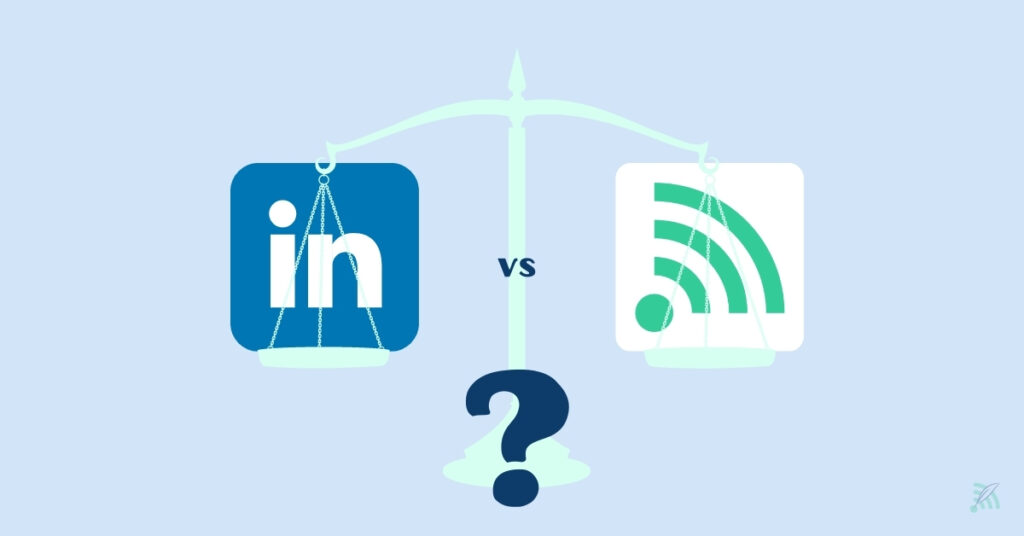LinkedIn articles are becoming increasingly popular and generate good engagement. Blog posts shared via LinkedIn, on the other hand, at least seem to be losing popularity.
How could this be explained? Well, there is a wealth of objective and subjective possibilities and reasons for this, including the nature of the article, who is publishing or sharing it, and the target audience, who have their own needs/behaviors to name a few.
In this blog post (which we will be sharing as a LinkedIn article as well and will therefore keep it short) we take a look at some of the pros and cons of each publishing method. We’ll share the best way to proceed if you choose to publish using both channels and we will give you an outlook on other possibilities to get your content published repeatedly.
Pros and Cons of LinkedIn
Using LinkedIn is simple. You are allowed to publish articles directly on the site, without having to set up and maintain a website or blog. It also provides easy-to-understand inbuilt analytics, especially when compared to Google Analytics.
Publishing articles on LinkedIn helps to
✅ Build and increase LinkedIn authority
✅ Reach a potentially larger or varied audience
✅ Provide information on reader locations, and
✅ Promote engagement.
As with every tool, there are certain drawbacks. The most prominent pitfall of using only LinkedIn as the primary platform to publish is:
➖ LinkedIn owns your content.
There are also:
➖ no SEO benefits
➖ no control over visual appearance or feel, making it
➖ difficult to convert leads into customers.
To top it all off, you are limited with word count. Research has shown that long-post formats of at least 1,500 words long get more engagement, especially in the B2B space.
Pros and Cons of Blog Posts
Managing a website or a blog can be technically demanding. However, you are have more freedom as you own your content, you can control your content offerings and its look and feel. As long, as you continuously provide authoritative and relevant content, you can keep attracting an audience.
Publishing articles to your blog helps to:
✅ Establish authority on your own domain
✅ Benefit from SEO
✅ Have full control over visual appearance
✅ Leverage inbound-marketing
✅ Supports conversion from leads into customers.
This means that when someone finds your blog post interesting, you can guide them to similar posts or ask them to subscribe to your newsletter or follow you on social media.
Publishing on your blog only without further sharing on other platforms, such as LinkedIn, can have drawbacks including:
➖ A possible smaller audience.
When sharing blog posts to your LinkedIn profile (instead of writing LinkedIn articles) your LinkedIn audience may feel
➖ Not ready to leave the platform to visit your blog post to find out if it’s relevant to them or not.
These lists can be extended, depending on who is looking at it, and with what agenda.
What is the Best Solution?
Comparing both options, it seems sensible to publish on both platforms for maximum advantage.
So, what about duplicate content? The good news is that Google won’t penalize you for publishing articles on both your blog and your LinkedIn account. It recognizes that you are the legitimate owner via your name or company.
This is the best way forward
1) Start by Publishing your Article as a Blog Post
For maximum visibility, publish your article as a blog post as the first step. Follow the best practice and include attractive visuals, CTA’s, and optimize with keywords and on-page SEO.
2) Speed up Google indexing
Register your post in the Google Search Console to speed up its appearance on Google. This is important, especially for time-sensitive announcements as Google can take a long time to index.
Generally speaking, search engines, such as Google, will credit your website or blog as the original source of the content, meaning you gain domain authority. You are also listed as the owner of the content.
3) Publish your Article on LinkedIn
Once indexed, you can publish on LinkedIn (or other platforms). Use the text from your blog as it is, or, even better, tweak the headlines and introduction slightly. Why? This can help your content appear in different searches thanks to SEO. Also, omit complex design elements and conclude your LinkedIn article with a link to the original content on your website.
4) Promote your Article and Engage with Followers
Although this is obvious, the success of your article or content depends largely on promotional tactics and, of course, your timely and effective engagement. So don’t forget to prompt and maintain discussion (on your blog or LinkedIn) and provide further insight when needed.
Can blog posts be published elsewhere?
As already mentioned, it is perfectly fine to republish blog posts on other platforms, such as Medium. Again, don’t worry about duplicate content penalties. They apply mainly if done on large scale (spamming) or if the content is effectively stolen from someone without giving credit (plagiarism).
Blog posts (or elements of it) can also be re-purposed and the information re-used across different platforms. The key is to share the same information in as many ways as possible so that it reaches a wider audience.
Best practice tip: Add a “this content has been published originally at x” and link to your original post, to make attribution clear.
Conclusion
You are allowed to and should distribute your articles and content to various platforms to maximize its effect. Always remember to post on your website first, have your content indexed by Google, and then republish on LinkedIn and other platforms.
Need a helping hand? Medtextpert can help you generate fresh, well-researched, and informative content that promotes engagement and helps you to get noticed on any platform.




